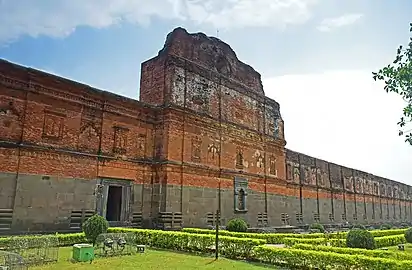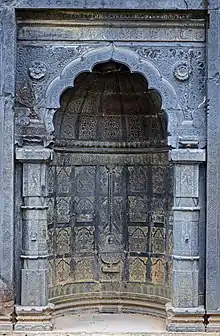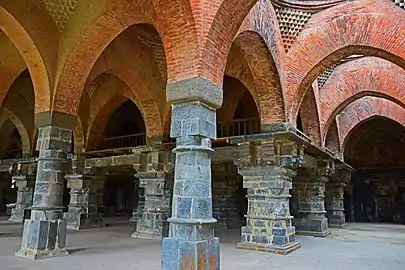Adina Mosque
The Adina Mosque is a former mosque in Malda District, West Bengal, India. It was the largest such structure in the Indian subcontinent and was built during the Bengal Sultanate as a royal mosque by Sikandar Shah, who is also buried inside. The mosque is situated in Pandua, a former royal capital.
| Adina Mosque | |
|---|---|
 Exterior facade of the mosque | |
| Religion | |
| Affiliation | Islam |
| District | Malda |
| Province | West Bengal |
| Ownership | Government of West Bengal |
| Location | |
| Location | Pandua |
| Country | India |
 Shown within West Bengal  Adina Mosque (India) | |
| Geographic coordinates | 25°09′08″N 88°09′53″E |
| Architecture | |
| Type | Mosque |
| Style | Islamic |
| Groundbreaking | 1373 |
| Completed | 1375 |
The vast architecture is associated with the hypostyle of the Umayyad Mosque, which was used during the introduction of Islam in new areas. The early Bengal Sultanate harbored imperial ambitions after having defeated the Delhi Sultanate twice in 1353 and 1359. The Adina Mosque was commissioned in 1373. Its construction absorbed materials from pre-Islamic Hindu and Buddhist structures.[1] The Bengal Sultanate disintegrated during the sixteenth century with the rise of the Mughal Empire.[2]
Adina Mosque is included in the List of Monuments of National Importance in West Bengal by the Archaeological Survey of India (serial no. N-WB-81).[3]
Design

The design of the mosque incorporated Bengali, Arab, Persian and Byzantine architecture. Although the mosque is eye-catching from far because of its size, but because of the finely precise executed designed decoration makes it hard to see the characteristics it holds without standing in a good distance from it. It was built with rubble masonry that was covered with brick, stone, coatings of stucco, plaster, concrete, glazing or lime smoothing. [1]Stone flowers were integrated into the arches of the interior and exterior all around the building.[4] Its plan is similar to the Great Mosque of Damascus.[5] It had a rectangular hypostyle structure with an open courtyard. There were several hundred domes. The structure measured 172 by 97 m. The entire western wall evokes the imperial style of pre-Islamic Sasanian Persia. The mosque's most prominent feature is its monumental ribbed barrel vault over the central nave, the first such huge vault built in the subcontinent, and another feature shared in common with the Sassanian style. The mosque consciously imitated Persianate imperial grandeur.[6] The prayer hall is five aisles deep, while the north, south and east cloisters around the courtyard consist of triple aisles. In total, these aisles had 260 pillars and 387 domed bays. The interior of the courtyard is a continuous façade of 92 arches surmounted by a parapet, beyond which the domes of the bays can be seen. The ornament on the building is simple, but if you look closer you can see the intensity and disciple in the engravings that have been created on the walls and arches.[1] The interior elevated platform, which was the gallery of the Sultan and his officials, still exists. The Sultan's tomb chamber is attached with the western wall.[4]
History
Accounts of Pandua


.jpg.webp)

.jpg.webp)
The mosque was built during the reign of Sikandar Shah, the second Sultan of the Ilyas Shahi dynasty of the Bengal Sultanate. The mosque was designed to display the kingdom's imperial ambitions after its two victories against the Delhi Sultanate in the 14th century.[7] According to Encyclopedia Iranica, the mosque's construction material included stone from Bengali temples.[6] A few parts of the mosque's exterior wall have carvings like elephants and dancing figures. Historians have considered whether the builders used stone from pre-Islamic structures or whether the mosque was built on the site of a pre-existing ruin. Inscriptions on the mosque proclaimed Sikandar Shah as "the exalted Sultan" and the "Caliph of the faithful".[8] The Sultan was buried in a tomb chamber attached to the wall facing the direction of Mecca.
The mosque was located in the historic city of Pandua, a former capital of the Bengal Sultanate. Pandua was a thriving and cosmopolitan trading center during the period of the sultanate.
According to the accounts of Chinese envoy Ma Huan, Pandua developed from a small hamlet into a capital city with a military garrison and then a commercial, manufacturing and trade center. Its population included royalty, indigenous people, and foreigners from across Eurasia who settled or were part of a floating population. It was a walled city with well-arranged streets and bazaars. The marketplaces sold many kind of goods, including six varieties of muslin and four types of wine. The markets included eateries, drinking houses and bathing areas. The Sultan's residence was a white mansion. Alcohol was not served in the royal court.[9]
Another remnant of the former royal capital that still stands is the Eklakhi Mausoleum. The main structure of the royal palace, with its high steps, nine walls and three gates, no longer exists. Remnants of the palace, including floral carvings, can be seen in Pandua's raised mounds.[9] The mixture of seemingly Buddhist, Hindu, and Islamic decorative characteristics of Adina Mosque has been questioned by many people. Wondering if this building is considered Islamic architecture or not, but with careful study it has become clear that this building was put together using Islamic traditions used in many other islamic architecture.[1]
Modern era
The mosque was damaged by earthquakes in the 19th century. It fell into disuse. Much of Pandua also became part of the wilderness.
Tribal rebellion
On 3 December 1932 AD, Jitu Santhal, the leader of an anti-landlord movement in North Bengal had engaged in his last combat at the ruins of the Adina mosque. A largeband of Santhals, who had recently converted to Hinduism, marched up to the historic city of Pandua, occupied the ruins of Adina, and conducted a debased form of Hindu worship in order to transform the mosque into a temple.
Jitu, who now called himself Gandhi, declared the end of British Raj and proclaimed his own government from within the mosque. Eventually, Jitu was killed in the vicinity of the mosque after a battle with armed police, who opened fire after the Santhals refused to come out.
See also
References
| Wikimedia Commons has media related to Adina Mosque. |
- "The architecture and architectural decoration of the Adina Mosque, Pandua, West Bengal, India: The problem of the conjoined Buddhist, Hindu and Islamic motifs in the mihrab niches - ProQuest". ProQuest 304044113. Cite journal requires
|journal=(help) - Eaton, Richard M. (1996). The Rise of Islam and the Bengal Frontier, 1204-1760. University of California Press. ISBN 978-0-520-20507-9.
- "List of Ancient Monuments and Archaeological Sites and Remains of National Importance". West Bengal. Archaeological Survey of India. Archived from the original on 27 June 2014. Retrieved 17 April 2020.
- Banerji, Naseem Ahmed (1 January 2002). The Architecture of the Adina Mosque in Pandua, India: Medieval Tradition and Innovation. Edwin Mellen Press. ISBN 9780773472099 – via Google Books.
- Hasan, Perween (15 August 2007). Sultans and Mosques: The Early Muslim Architecture of Bangladesh. I.B.Tauris. ISBN 9781845113810 – via Google Books.
- electricpulp.com. "BENGAL – Encyclopaedia Iranica".
- Eaton, Richard Maxwell (1996). The Rise of Islam in the Bengal Frontier, 1204-1760. University of California Press. pp. 40–50. ISBN 0520205073.
- "Adina Mosque - Banglapedia".
- María Dolores Elizalde; Wang Jianlang (6 November 2017). China's Development from a Global Perspective. Cambridge Scholars Publishing. pp. 61, 68 and 69. ISBN 978-1-5275-0417-2.